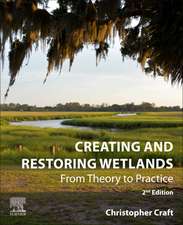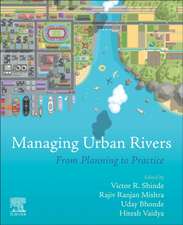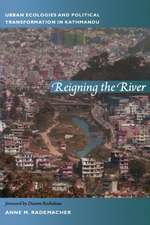Ramsar Wetlands: Values, Assessment, Management
Editat de Peter Gell, Nick Davidson, Max Finlaysonen Limba Engleză Paperback – 21 aug 2023
No other book has yet taken this broad look at the past, present and future of wetlands and the Ramsar Convention. From aquatic ecologists, environmental scientists and engineers, to water resource managers, conservation agencies, and land management planners, this comprehensive guide is a beneficial tool in understanding wetlands.
- Answers questions on the responsibilities and roles of signatory nations to the Ramsar Convention, including how it may deal with ongoing and emerging causes of wetland change
- Addresses ongoing challenges of reporting and managing wetland change
- Provides a multidisciplinary approach and details the wise use principle that underpins the convention
Preț: 743.34 lei
Preț vechi: 906.51 lei
-18% Nou
142.26€ • 147.97$ • 117.44£
Carte disponibilă
Livrare economică 25 martie-08 aprilie
Livrare express 08-14 martie pentru 50.09 lei
Specificații
ISBN-10: 0128178035
Pagini: 360
Ilustrații: Approx. 150 illustrations
Dimensiuni: 152 x 229 x 33 mm
Greutate: 0.99 kg
Editura: ELSEVIER SCIENCE
Public țintă
Primary: university researchers/students in the fields of aquatic ecology, geography, general ecology, environmental science/engineering, botany and biology, as well as environmental policy.Secondary: water/soil resource managers, land management planners, conservation agencies and environmental management/protection agencies.
Cuprins
2 Ramsar Governance and Processes at the International Level
3 Ramsar at the national level: application and incorporation into domestic law
4 The extent and distribution of the world's wetlands
5 The Distribution of the World¿s Internationally Important Wetlands and their Contribution to
Global Protected Area Goals and Aichi Biodiversity Target 11
6 Linking Wetland Ecological Processes with the Delivery of Ecosystem Services
7 Ecosystem Services
8 The response of Wetlands to Long-Term Climate Change
9 What's Happening to the World's Wetlands
10 Cultural Landscapes: Human Impacts on Wetlands
11 Threats to wetlands: what¿s driving loss and degradation?
12 Wetland Monitoring: understanding variability and change in ecological condition
13 Trajectories in wetland condition: Setting Limits of Acceptable Change
14 Management effectiveness of wetland protected areas
15 Investing in Wetland Restoration: Practical Guidance and Looking Ahead
16 Human Culture and its evolving place in the Ramsar convention
17 International governance of water for biodiversity conservation
18 Climate Change and wetlands - vulnerability, adaptation, mitigation, resolutions and
scientific societies
19 Wetlands as social ecological systems: Bridging nature and society
20 Wetlands and Future Change - Implications and Opportunities for the Ramsar Convention
Descriere
Ramsar Wetlands: Values, Assessment, Management addresses the approaches, successes and limitations of the Ramsar Convention in a changing world, how recent approaches to wetland monitoring and management can contribute to improving wetland state, what the future holds for wetlands and their wise use, and what the Ramsar Convention needs to do to achieve future successes. The book presents a unique outlook on a range of issues, addressing considerable advances in our understanding of wetlands, their great environmental, social, cultural and economic importance, their role in maintaining the global water-cycle, and in mitigating and adapting to changing climates.
No other book has yet taken this broad look at the past, present and future of wetlands and the Ramsar Convention. From aquatic ecologists, environmental scientists and engineers, to water resource managers, conservation agencies, and land management planners, this comprehensive guide is a beneficial tool in understanding wetlands.
- Answers questions on the responsibilities and roles of signatory nations to the Ramsar Convention, including how it may deal with ongoing and emerging causes of wetland change
- Addresses ongoing challenges of reporting and managing wetland change
- Provides a multidisciplinary approach and details the wise use principle that underpins the convention
























